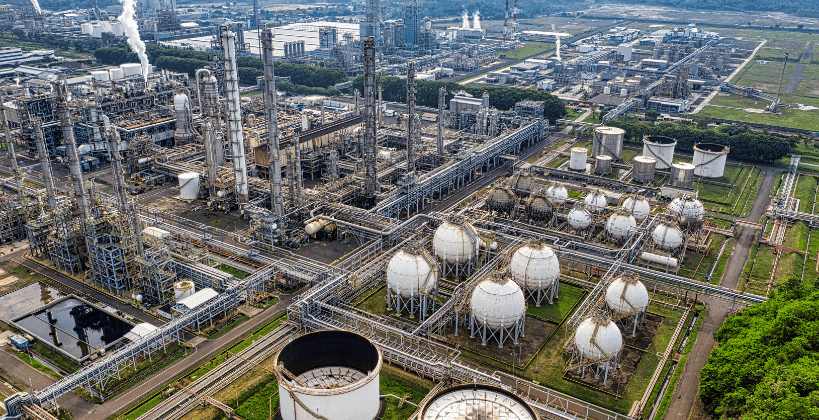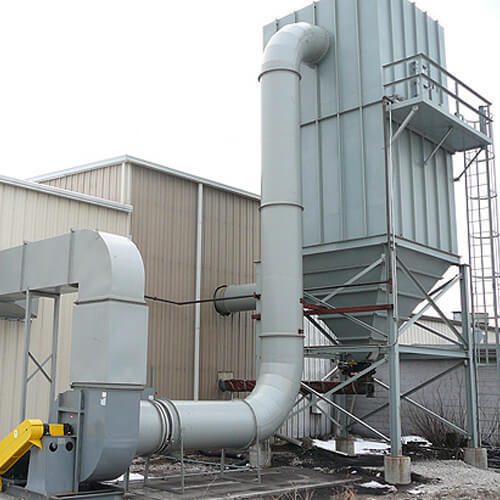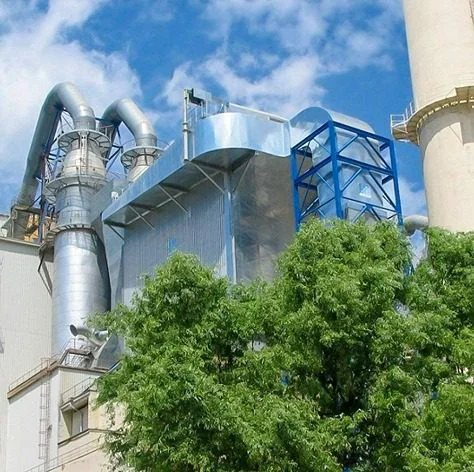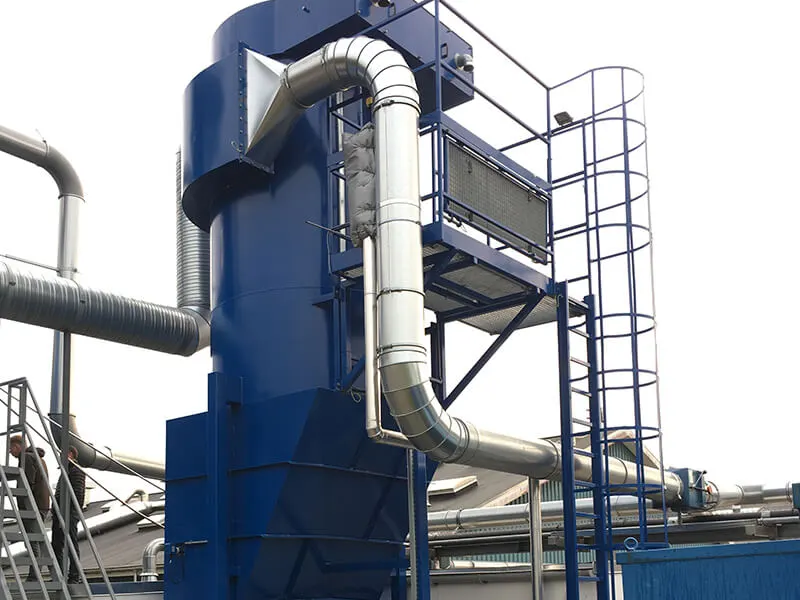Khi nói đến khả năng thu gom bụi và khói hiệu quả, bộ lọc tĩnh điện (ESP) từ lâu đã là giải pháp được ưa chuộng trong nhiều ngành công nghiệp. Tuy nhiên, việc lựa chọn giữa ESP khô và ESP ướt không hề đơn giản như bạn nghĩ.
Mỗi hệ thống đều có những ưu điểm, hạn chế và ứng dụng riêng cho từng ngành. Vậy làm thế nào để bạn quyết định loại nào phù hợp với nhà máy của mình?
Trong hướng dẫn này, chúng tôi sẽ so sánh ESP khô và ướt dựa trên các yếu tố quan trọng như hiệu suất, tính phù hợp của ứng dụng, môi trường vận hành, nhu cầu bảo trì và hiệu quả về chi phí, giúp bạn đưa ra quyết định sáng suốt cho chiến lược kiểm soát khí thải của mình.
Máy lọc tĩnh điện (ESP) là gì?
Máy lọc tĩnh điện là thiết bị lọc tiên tiến có tác dụng loại bỏ các hạt mịn như bụi, khói và sương mù ra khỏi luồng khí bằng cách sử dụng lực của điện tích tĩnh điện cảm ứng.
Cả ESP khô và ESP ướt đều hoạt động theo nguyên lý này, nhưng cấu tạo, phương pháp thu thập hạt và trường hợp sử dụng của chúng có sự khác biệt đáng kể.
Máy lọc tĩnh điện khô là gì?
Hệ thống ESP khô loại bỏ các hạt rắn khỏi khí thải bằng phương pháp ion hóa. Các hạt tích điện bị hút vào các điện cực thu gom tích điện trái dấu và sau đó được loại bỏ bằng lực rung cơ học, khiến bụi rơi vào phễu.
Đặc điểm chính:
Được sử dụng cho các hạt rắn như tro bay, bụi xi măng và bụi than
Các hạt được loại bỏ khô, không cần nước hoặc chà xát
Thông thường được lắp đặt ở hạ lưu của lò hơi, lò nung hoặc lò đốt
Yêu cầu cơ chế gõ để đánh bật bụi đã thu thập
Máy lọc tĩnh điện ướt là gì?
ESP ướt hoạt động tương tự như ESP khô nhưng được sử dụng cho các hạt ướt, dính hoặc hòa tan. Thay vì gõ, các hạt được rửa sạch khỏi đĩa thu bằng nước, lý tưởng để thu giữ sương mịn, khí dung và khói mà nếu không sẽ thoát ra khỏi hệ thống thu gom khô.
Đặc điểm chính:
Lý tưởng cho các hạt siêu nhỏ, sương mù, khói kim loại, giọt axit và bụi dính
Sử dụng vòi phun nước để rửa sạch các hạt khỏi điện cực
Phổ biến trong các ngành công nghiệp có độ ẩm cao hoặc khí ăn mòn
Loại bỏ bụi tái bám vào do thu gom ướt
Khám phá các giải pháp của chúng tôi:
So sánh song song: ESP khô so với ESP ướt
Tiêu chuẩn | ESP khô | ESP ướt |
|---|---|---|
Loại hạt | Các hạt rắn, khô | Các hạt ướt, dính, ăn mòn hoặc dưới micron |
Phương pháp làm sạch | Rap cơ học | Xả nước liên tục |
Hiệu quả thu thập | Cao đối với bụi thô (PM10) | Tuyệt vời cho các hạt siêu mịn (PM2.5 trở xuống) |
BẢO TRÌ | Yêu cầu bảo trì hệ thống rap | Cần quản lý nước và kiểm soát ăn mòn |
Điều kiện hoạt động | Dòng khí khô, nhiệt độ vừa phải | Dòng khí ẩm hoặc bão hòa, nhiệt độ thấp |
Khu vực lắp đặt | Lò hơi, lò nung xi măng, lò đốt rác | Nhà máy hóa chất, lò luyện kim, máy lọc FGD |
Chi phí vốn | Nói chung là thấp hơn | Chi phí ban đầu cao hơn do thiết kế chống ăn mòn |
Chi phí đang diễn ra | Thấp hơn (không sử dụng nước) | Cao hơn (do quản lý nước và ăn mòn) |
Ngành công nghiệp nào ưa chuộng ESP khô?
ESP khô là giải pháp được ưa chuộng trong các ngành công nghiệp mà khí thải chủ yếu là các hạt bụi khô. Các giải pháp này bao gồm:
Sản xuất xi măng – để loại bỏ bụi trong lò nung và máy làm mát clinker
Nhà máy điện đốt than – để loại bỏ tro bay
Ngành công nghiệp giấy và bột giấy – để lọc khí thải lò hơi
Chế biến thép và kim loại – cho khí thải lò nung
Đốt rác thải – để kiểm soát các hạt ở nhiệt độ cao
Chi phí vận hành thấp và hiệu suất đáng tin cậy trong môi trường khô khiến chúng trở thành giải pháp lý tưởng để loại bỏ hạt trong các ngành công nghiệp vật liệu rời.
ESP ướt có ưu điểm gì?
ESP ướt lý tưởng cho những tình huống mà khí thải bao gồm khí axit, hợp chất dính hoặc sương mù và khói siêu mịn mà các hệ thống khô truyền thống khó có thể thu được.
Các ngành công nghiệp thường sử dụng ESP ướt:
Sản xuất kim loại màu – luyện kẽm, đồng, nhôm
Nhà máy hóa chất và hóa dầu – để loại bỏ sương dầu và các giọt axit
Sản xuất thủy tinh – để kiểm soát sương mù chì và cadmium
Chế biến thực phẩm – nơi hơi nước và khí dung hữu cơ được phát ra
Hệ thống khử lưu huỳnh khí thải (FGD) – cho các giai đoạn đánh bóng
Khả năng xử lý các chất ô nhiễm ướt và dưới micron trong khi vẫn đảm bảo không có sự tái cuốn khiến chúng trở nên vô cùng hữu ích trong các lĩnh vực này.
Máy lọc tĩnh điện
Các yếu tố quyết định chính: Yếu tố nào phù hợp với bạn?

Việc lựa chọn giữa ESP khô và ướt phụ thuộc vào một số yếu tố cụ thể của từng loại cây:
1. Bản chất của khí thải
Thành phần và trạng thái vật lý của khí thải là những yếu tố cơ bản nhất cần cân nhắc.
- ESP khô phù hợp nhất cho các ứng dụng tạo ra các hạt vật chất khô, bay tự do, chẳng hạn như tro bay, bụi xi măng hoặc khói luyện kim. Các hạt này thường thô và có thể dễ dàng bị loại bỏ bằng máy gõ cơ học.
- ESP ướt là lựa chọn lý tưởng khi xử lý các hạt mịn, dính, dầu hoặc ướt, chẳng hạn như sương axit, khí dung kim loại hoặc chất hữu cơ ngưng tụ. Những hạt này thường được tìm thấy trong luồng khí thải từ các nhà máy hóa chất, lò luyện kim và cửa xả của hệ thống lọc ướt. Việc sử dụng nước để rửa sạch bề mặt thu gom giúp ESP ướt hiệu quả hơn trong việc xử lý các loại khí thải khó xử lý này.
2. Đặc điểm của dòng khí
Nhiệt độ, độ ẩm và thành phần hóa học của khí quy trình có tác động trực tiếp đến hiệu suất và độ bền của hệ thống ESP.
- ESP khô Hoạt động tối ưu trong môi trường khí có nhiệt độ cao, độ ẩm thấp, chẳng hạn như khí thải từ lò nung xi măng, lò hơi đốt than và lò đốt rác. Các hệ thống này được thiết kế để chịu nhiệt và duy trì hiệu suất mà không bị ăn mòn.
- ESP ướt được thiết kế cho các dòng khí bão hòa, nhiệt độ thấp và ăn mòn, nơi hơi nước hoặc hợp chất hóa học có thể ngưng tụ và gây ra sự cố trong hệ thống khô. Các hệ thống này được chế tạo bằng vật liệu chống ăn mòn như thép không gỉ hoặc hợp kim cao cấp để ngăn ngừa hư hỏng.
3. Mức hiệu quả mong muốn
Mỗi ngành công nghiệp có tiêu chuẩn tuân thủ khác nhau, đặc biệt là khi ngày càng chú trọng vào lượng khí thải cực thấp.
- ESP khô có hiệu quả cao trong việc thu gom các hạt lớn hơn (ví dụ: PM10), thường đạt hiệu quả loại bỏ lên tới 99% đối với bụi thô.
- ESP ướtMặt khác, công nghệ này vượt trội trong việc loại bỏ các hạt siêu mịn (PM2.5 trở xuống), khí dung và khói ngưng tụ. Chúng có thể đạt mức phát thải cực thấp, khiến chúng trở thành công nghệ được lựa chọn hàng đầu khi các tiêu chuẩn môi trường nghiêm ngặt được áp dụng.
4. Những cân nhắc về bảo trì
Mỗi loại ESP đều có nhu cầu bảo trì riêng, phù hợp với nhân lực, cơ sở hạ tầng và khả năng chịu đựng thời gian chết của nhà máy.
- ESP khô đòi hỏi phải bảo dưỡng thường xuyên các đầu lọc, điện cực và phễu, cũng như vệ sinh định kỳ để đảm bảo loại bỏ bụi liên tục. Chúng đòi hỏi nhiều công sức về mặt cơ khí nhưng hầu hết người vận hành nhà máy đều hiểu rõ.
- ESP ướt Cần có hệ thống tuần hoàn nước liên tục, vòi phun và hệ thống thoát nước để loại bỏ các hạt. Việc quản lý hóa chất nước đúng cách là rất cần thiết để ngăn ngừa cặn bẩn hoặc bám bẩn sinh học. Việc theo dõi ăn mòn cũng rất quan trọng, đặc biệt là với các thành phần khí độc hại.
5. Ràng buộc ngân sách
Chi phí luôn là một yếu tố, nhưng phải cân nhắc với hiệu suất lâu dài, lợi ích về môi trường và tiết kiệm chi phí vận hành.
- ESP khô thường liên quan đến mức đầu tư vốn thấp hơn và chi phí vận hành đơn giản hơn, đặc biệt là trong các ứng dụng có vật chất dạng hạt khô và có thể dự đoán được.
- ESP ướt Nhìn chung, chi phí đầu tư ban đầu cao hơn do vật liệu chống ăn mòn, hệ thống tuần hoàn nước và độ phức tạp tăng thêm. Tuy nhiên, trong những môi trường mà hệ thống thu gom khô không hiệu quả hoặc đòi hỏi bảo trì cao hơn, hệ thống ESP ướt mang lại độ tin cậy cao hơn và rủi ro liên quan đến khí thải thấp hơn.
Intensiv Filter Himenviro: Đối tác giải pháp ESP của bạn
Cho dù nhà máy của bạn cần một hệ thống ESP khô mạnh mẽ cho các quy trình nhiều bụi hay một hệ thống ESP ướt chính xác để kiểm soát sương mù và khói, Intensiv Filter Himenviro cung cấp các hệ thống được thiết kế riêng để đáp ứng các mục tiêu về môi trường và vận hành của bạn.
Tại sao chọn chúng tôi?
Nhiều thập kỷ kinh nghiệm thiết kế và kỹ thuật ESP
- Các công trình đã được chứng minh trong ngành xi măng, điện, hóa chất và kim loại
- Hiệu quả cao, CPCB/NGT-giải pháp tuân thủ
- Hỗ trợ vòng đời và giao hàng toàn cầu
- Dịch vụ cải tạo và nâng cấp có sẵn cho các nhà máy hiện có
Các giải pháp ESP của chúng tôi được thiết kế không chỉ để tuân thủ mà còn mang lại độ tin cậy, độ bền và sự an tâm.
Cần trợ giúp để chọn ESP phù hợp?
Mỗi nhà máy đều khác nhau. Khí thải, điều kiện quy trình và mục tiêu môi trường đều khác nhau. Đó là lý do tại sao chúng tôi không tin vào một giải pháp chung cho tất cả.
Hãy để các chuyên gia của chúng tôi giúp bạn xác định công nghệ phù hợp cho nhà máy của bạn, dựa trên hiểu biết sâu sắc về kỹ thuật, kiểm toán khí thải và dữ liệu hiệu suất thực tế.







